Save dying zinnia plants by giving them more sun, liquid seaweed solution and a gentle fertilizer. Protect them from cold weather and frosts by moving them near a masonry wall or give them a home in a greenhouse. Deep soak very dry potted plants to help to rehydrate the soil and repot them if the soil level has dropped.
Zinnia plants are summer growing annuals so will die off in cooler climates in the fall. If you live in a mild climate they can continue to grow into fall or even into winter.
Zinnia plants are generally easy to grow but if they look like they are dying then there are some steps you can take to save them.

This article will explore 9 easy steps to save a dying zinnia plant.
If your zinnias are dying in spring and summer then you will need to check that all of their needs are met. This list below will help you to work out why your zinnias are dying and what you can do to save them.
How to save a dying zinnia plant
Here are my 9 easy steps to save a dying zinnia plant at home.
1. Check the season
Zinnia plants are spring and summer annuals and will die back at the end of the season. If the plant is started to turn brown, wilt and flowers have stopped blooming then it could just be a natural end of their growing cycle.
To extend the life of your zinnia plants in cooler weather, place them near a brick wall so the radiant daytime heat continues overnight. Move them to a frost protected area or move them into a greenhouse. This can help these summer loving plants to keep growing for longer in the cool season.
2. Check for diseases and pests
Check your dying zinnia plants for pests and diseases. Black leaves can be a sign of fungal growth which can cause the plant leaves to die back. Fungal disease can be treated with copper fungicides or if you prefer to avoid using these in your yard, trim off the affected leaves.

If the whole zinnia plant is developing this fungus, it is better to remove the plant and avoid the infection spreading to your other zinnias.
Black leaves can also be caused by overwatering, so check your soil. If it is continually wet then add some mulch and slow down your watering schedule. Plants can recover quickly when watering is reduced. Zinnias actually prefer to dry out slightly between watering so check the soil first.
Check out my article here on zinnia disease and fungus:
3. Check the soil
Poor soil can cause zinnia plants to die off over time. The organic matter in the potting soil will break down over time reducing the amount of oxygen available in the soil. The soil level can drop and the plant will struggle to grow well.

Repotting zinnias is very easy and can help to save a dying plant. Choose a nice new, clean pot that is only around 1 inch wider and deeper than the current pot that it is in. Use good quality potting soil to grow your plant which will have some added fertilizer and fresh, new organic matter.
You can also transplant zinnia plants into the ground if you can find a protected, sunny position. I like to improve the soil with a small amount of cow manure and compost. Dig it through the soil to lighten the soil.
Plant your struggling zinnia plant into the new space in the garden. Trim off any old flower heads to allow room for the sun to reach the lower leaves of the plant.
4. Fertilize the plant well
If your zinnia is planted in the ground or is already growing in good quality potting soil then it can benefit from a boost of fertilizer. Dying zinnia plants can benefit from liquid all-purpose of nitrogen based fertilizer.

I like to use a fish emulsion fertilizer that is naturally made but any general nitrogen-based fertilizer will work. Liquid fertilizer is absorbed quickly by the plant and can help it to recover. Nitrogen based fertilizer will help the plant to replace its leaves.
Liquid fertilizer is short lasting so add some all-purpose slow release fertilizer after 2 weeks. I like pelleted chicken manure but an all-purpose fertilizer will work.
5. Deep water dry plants
Check the top of the potted plants to see if the soil is dry. To revive a dry zinnia plant growing in a pot, deep soak it in a bucket of water with a dash of seaweed solution. Submerge the pot but keep the water level just below the edge of the pot.
Submerge it for around 5-10 minutes or until there are no more bubbles floating up from the potting soil.
Take the pot out of the water and let it drain on your lawn for 5 minutes or until it stops dripping. You can then return it to your pot tray. The seaweed water will also help to feed your lawn so you can pour the rest over after you have finished.
You can also water the plant deeply with seaweed solution diluted in water. I find that soaking the plant helps to hydrate the soil more thoroughly and the plant will recover quicker/
6. Give them more sun
Zinnia plants can suffer and die if they are not getting enough sun. The simple solution is to move them into a position that gets at least 6 hours of sun. The more sunlight the plant gets, the more likely it is to recover.

If your zinnia plants are dying at the end of the summer season, you can extend their life by moving them into a brighter position. Remember to keep them watered and trim off any old flowers.
7. Give them frost protection
Dying zinnias can be saved and can continue to grow into the cooler months if they are protected from frosts. Potted zinnias can be moved near masonry walls or move them under a verandah at the end of the day. The next morning, once the sun arrives and the frosts have passed, they can be moved back out into the open.
8. Remove old leaves and flowers
To help zinnias recover and bounce back from a near death experience, trim off old flowers and any stem tips that are turning brown. Remove small amounts of stem at a time and make sure there are still plenty of leaves left on to catch the sun and photosynthesize.
Old flowers can be thrown in your compost bin to break down if they are disease free.
9. Mulch the plant well
The final step to save a dying zinnia plant is to mulch around the root zone. Mulch will help to reduce weed competition for zinnias grown in the ground, it helps to regulate soil moisture and will gently feed the soil. I like to use bark mulch but you can use straw or sugar cane or whatever you have on hand.
How to save a dying zinnia | Summary
Zinnias that are developing brown, black or yellow leaves and look like they are dying can be saved. They love warm weather, frost free conditions and good soil. Repotting dying zinnias can be the easiest way to give their roots the nutrients and oxygen they need to thrive and recover. Deep soak dry zinnia pots to rehydrate the soil and help them to recover faster.
Happy growing.
I am an accredited practicing dietitian, experienced gardener and a dedicated cook. I love writing and sharing my experience so you can learn from my successes and mistakes.
